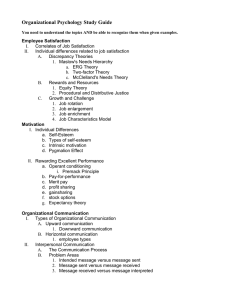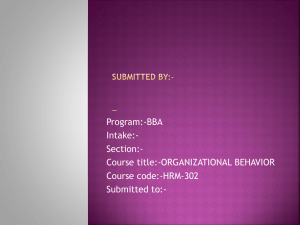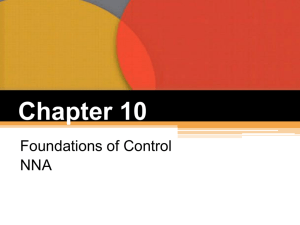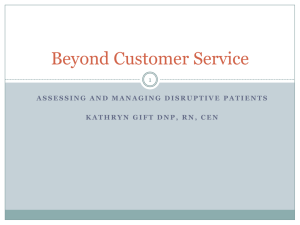BUS151 CH10 PPT - Carteret Community College
advertisement
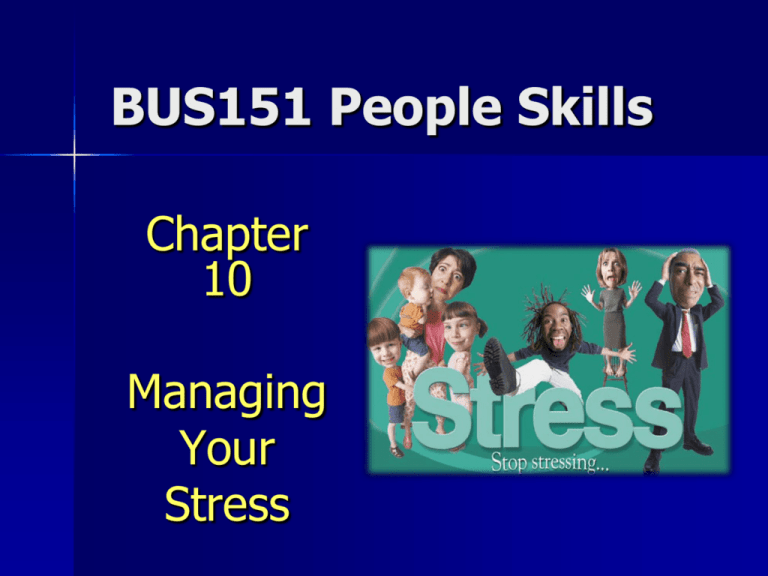
BUS151 People Skills Chapter 10 Managing Your Stress Stress Research Stress has been linked to all of the leading causes of death, including: – – – – – Heart disease Cancer Lung ailments Accidents Suicide Dealing with stress is a major health-related issue today. Stress is America’s #1 health problem. Stress Research 43 percent of adults suffer adverse health effects due to stress. 75-90 percent of the visits to primary care physicians are due to stress. 1 million estimated workers are absent on an average workday because of stress-related complaints. 60 percent of employee absences were due to psychological problems such as stress. Job stress is estimated to cost U.S. industry $300 billion annually, as measured by absenteeism, diminished productivity, employee turnover, and medical, legal, and insurance fees. Workplace violence is rampant. Almost 2 million cases of homicide, aggravated assault, rape, or sexual assaults are reported each year. What is Job Stress? Defined as the harmful physical and emotional responses that occur when the requirements of a job do not match the capabilities, resources, or needs of the worker. Bad stress (distress): – Causes problems in dealing with customers and other people. – Reduces your effectiveness. – Dampens your motivation. – Makes your life miserable. Eustress (good stress) You would experience eustress if you set a goal for yourself and achieved that goal. You may go through the same psychological stages that you would for negative situations, but at the end, when you reach your goal, you have a sense of accomplishment and a feeling of exhilaration. Fight or Flight Syndrome When your brain recognizes or perceives danger or stress, it triggers a chain reaction of events, starting with the release of chemicals (adrenaline) into the nervous system. Your heart starts beating faster, sending more blood throughout the body. Your breathing accelerates so that you take in more oxygen so that you are ready to deal with the situation (fight) or perhaps to leave the area (flight). In the customer service environment, increased levels of adrenaline can be helpful in solving customer problems, or it can cause problems if you lose control. On the positive side, getting excited about a project can work in your favor. This is especially true when deadlines are tight for extended periods. On the negative side, increased levels of adrenaline can create problems in maintaining the customer-provider relationship. It may lead you to react inappropriately (fight). In such instances, you must remain professional and maintain control. You may need to excuse yourself and seek a supervisor or someone else to handle the situation flight). The speed at which customers expect product and service delivery in the 21st century will likely increase. Current systems efficiency is causing customers to keep demanding faster service. Some of the things that fuel such expectations are: • • • • • • • • • • Instantaneous access to information via the Internet ATM banking. Microwave ovens. Supermarkets that include multiple services (banking, pharmacies, hair styling, manicure/pedicure services, etc.) Fax machines. One-hour photo processing. Convenient stores open 24 hours a day. Beepers, cell phones Drive-through an drive-in services such as laundry, dry cleaning. Electronic IRS filing Recognizing Stress Inability to focus or concentrate on a customer problem or workplace situation. Irritability in dealing with others in the workplace. Excessive fatigue which prevents you from operating at full potential. Intestinal irritation that can affect your appetite or cause you to be absent from work. Tardiness or absenteeism because of physical symptoms or the need to catch up on sleep. Being argumentative or aggressive Recognizing Stress Nail biting or other nervous habits, such as playing with hair, tapping object or foot, wringing hands. Poor attitude, which manifests itself in phrases like “Whatever,” or “Tell someone who cares.” Bingeing on food, alcohol, or tobacco. Feelings of depression, crying spells, or feeling uselessness and being underappreciated. Pains in the stomach or head, neck, or muscle pains, rapid pulse, high blood pressure, or irregular menstrual cycles. Environmental Factors PEOPLE Physical factors such as noise, odors, bright or dim lighting, and heat or cold might affect you more than they affect others. Occupational hazards that cause you to be concerned about safety, such as dangerous people or situations, heavy equipment, flammable caustic, etc. Nonergonomic situations in which chairs, tables, computer equipment, and other tools do not conform with industry standards related to employee protection, comfort, and safety. Organizational elements such as changes in structure, technology, etc. Environmental Factors JOB FACTORS Job structures that require you to work various shifts or overtime. Job insecurity often due to lack of adequate and effective communication from upper management. Unreasonable goals in evaluating job performance leading to low morale, resentment, frustration. Limited authority to make decisions or assist customers. Conflicting demands may cause you not to be able to achieve the degree of success that you desire. Repetitive tasks that require little or no opportunity for initiative or change in routine. Limited opportunities for advancement which dampen desire to excel. Environmental Factors PERSONAL FACTORS Relationships Physical condition and nutrition Inability to solve problems Chemical use Financial problems Lack of “alone” time Overworking Avoiding Stress Through Effective Communication Effective communication techniques such as politeness, being assertive rather than aggressive, and expressing your feelings are a few ways that you can avoid stress. Maintaining Your Sanity Maintaining your sanity means that you take active and positive steps to reduce your stressful situations. Managing your time effectively, setting realistic goals, and taking frequent breaks are a few steps that can help. Stay calm and smile. Manage time effectively. Avoid procrastination. Prioritize tasks. Set realistic goals. Take frequent breaks. Exercise regularly. Eliminate vagueness. Reduce personal tension. Use positive self-talk. Vary your activities. Get more sleep. Find a hobby. Workplace Violence Changes in the workplace Substance abuse Shifting values and beliefs Violence on TV and din the movies General trend to lash out at others in the form of verbal or physical assault. The retail trade and service industries account for 56% of the workplace homicides, and 85% of nonfatal workplace assaults. Statistically , persons in greatest potential peril are employees whose jobs involve routine public contact. General Characteristics of Potential Offenders White male between 35-45 years of age. History of job changes. Takes constructive criticism and feedback poorly. Is interested in weapons and firearms. Identifies with or talks about violence. Is a loner who has few friends; little family contact. Fails to take responsibility or blame when errors occur. May use drugs and/or alcohol. Depression or threatening behavior.







